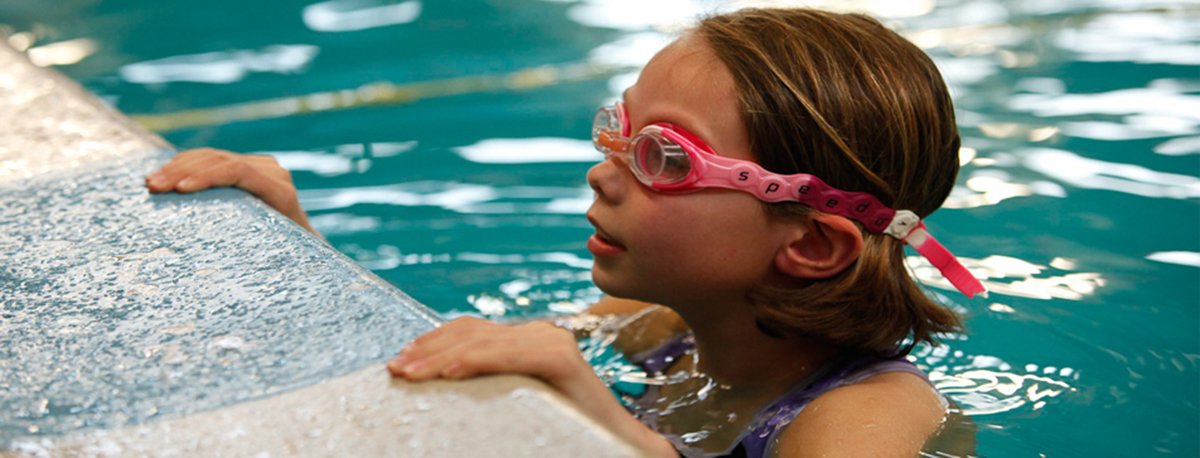
Improvers – Stages 4 – 7
Our improver groups are encouraging and exciting. This level of swimmer finds our lessons very rewarding as they are making big steps each term. We provide our swimmers with small groups ensuring recognition of each swimmers effort and enjoyment out of our swimmers. We notice our swimmers progression and actively encourage our swimmers.
Stage 4
Stage 4 sees swimmers perfect their leg kicks for all four strokes and further develop push and glides, while also being introduced to the important lifesaving skill of sculling. Our swimmers will develop an understanding of buoyancy through a range of skills and should swim 10 metres to the Swim England Expected Standards.
By the end of stage 4, swimmers are expected to have a clear ability to perform recognisable leg kicks for all four strokes.
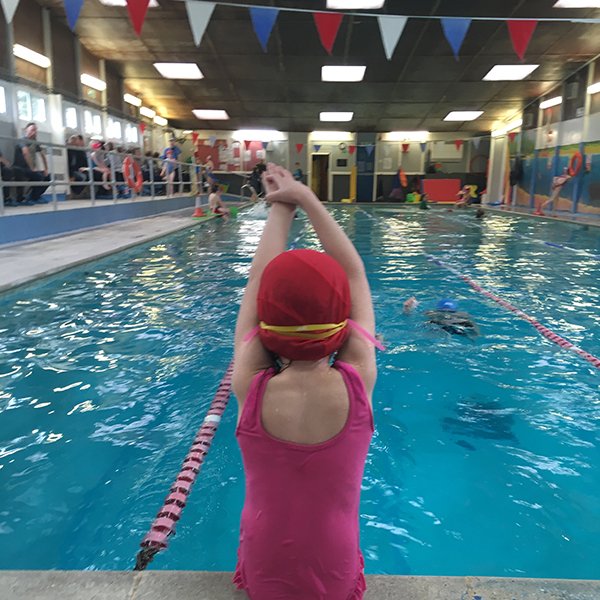
Stage 4 Curriculum
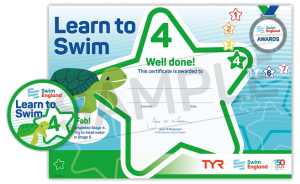
By completing this Award, without floatation equipment or support, you will be able to:
- Perform a sequence of changing shapes (minimum of three) whilst floating on the surface and demonstrate an understanding of floating.
- Push and glide from the wall towards the pool floor.
- Kick 10 metres backstroke (one item of equipment optional).
- Kick 10 metres front crawl (one item of equipment optional).
- Kick 10 metres butterfly on the front or on the back.
- Kick 10 metres breaststroke on the front (one item of equipment optional).
- Perform a head first sculling action for 5 metres in a flat position on the back.
- Travel on back and log roll in one continuous movement onto front.
- Travel on front and log roll in one continuous movement onto back.
- Push and glide and swim 10 metres, choice of stroke is optional.
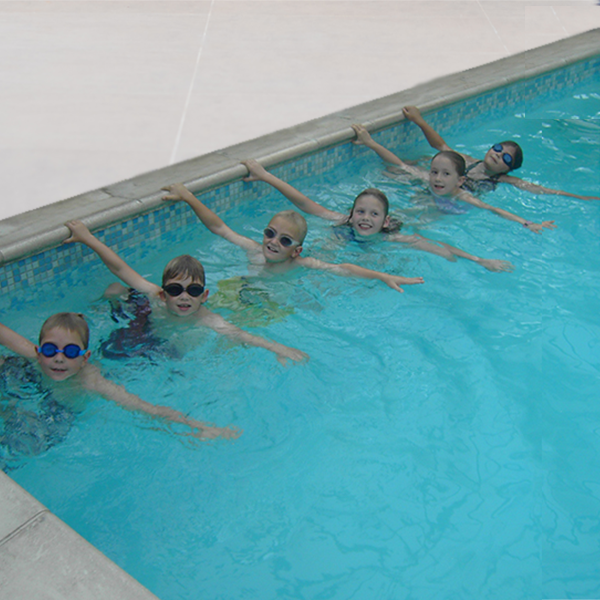
Stage 5
During Stage 5, swimmers will develop their skills in treading water, learn the correct arm pulls for all four strokes and learn how to do handstands and somersaults. This means they will develop their technique and perform all strokes ‘recognisably’ to the Swim England Expected Standards. The emphasis is on ensuring all work done in the previous stages is developed further.
A key activity in Stage 5 is sculling, which is an important skill to master – sculling is vital to ensuring water safety.
Learning to tread water is an important area of development and again is a crucial lifesaving skill.
Stage 5 Curriculum
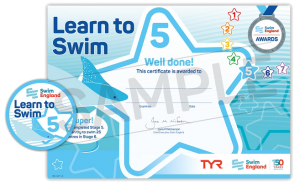
By completing this Award you will be able to:
- Perform a flat stationary scull on the back.
- Perform a feet first sculling action for 5 metres in a flat position on the back.
- Perform a sculling sequence with a partner for 30-45 seconds to include a rotation.
- Tread water for 30 seconds.
- Perform three different shaped jumps into deep water.
- Push and glide and swim 10 metres backstroke (performed to Swim England expected standards).
- Push and glide and swim 10 metres front crawl (performed to Swim England expected standards).
- Push and glide and swim 10 metres breaststroke (performed to Swim England expected standards).
- Push and glide and swim 10 metres butterfly (performed to Swim England expected standards).
- Perform a handstand and hold for a minimum of three seconds.
- Perform a forward somersault.
- Demonstrate an action for getting help.
Stage 6
Stage 6 teaches swimmers how to prepare for exercise, while developing an efficient technique for all four strokes and further developing surface dives. The effective swimming skills taught include coordination, breathing and an understanding of water safety. Within this stage, swimmers will work on all the strokes, including streamlining, improving their technique with both their arms and their legs.
Swimmers will also learn Water Safety including swimming in clothes and understand how to be safe when they’re in and around water.
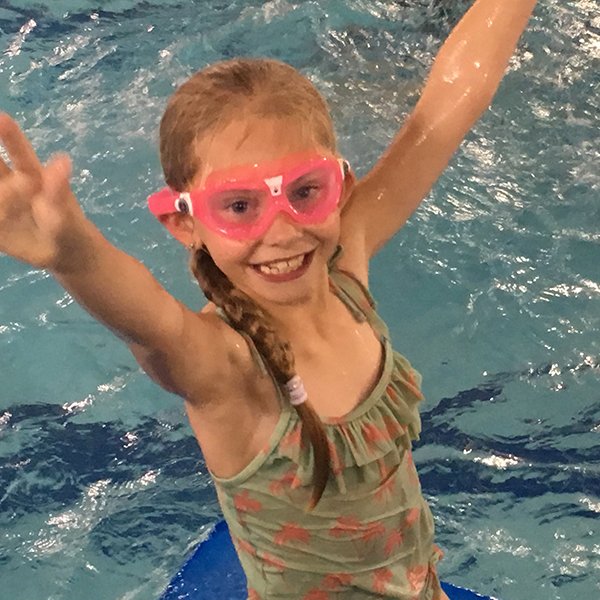
Stage 6 Curriculum
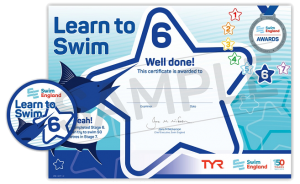
By completing this Award you will be able to:
- Give two examples of how to prepare for exercise and understand why it is important.
- Sink, push off on side from the wall, glide, kick and rotate into backstroke.
- Sink, push off on side from the wall, glide, kick and rotate into front crawl.
- Swim 10 metres wearing clothes.
- Push and glide and swim front crawl to include at least six rhythmical breaths.
- Push and glide and swim breaststroke to include at least six rhythmical breaths.
- Push and glide and swim butterfly to include at least three rhythmical breaths.
- Push and glide and swim backstroke to include at least six regular breaths.
- Push and glide and swim 25 metres, choice of stroke is optional (performed to Swim England expected standards).
- Perform a ‘shout and signal’ rescue.
- Perform a surface dive.
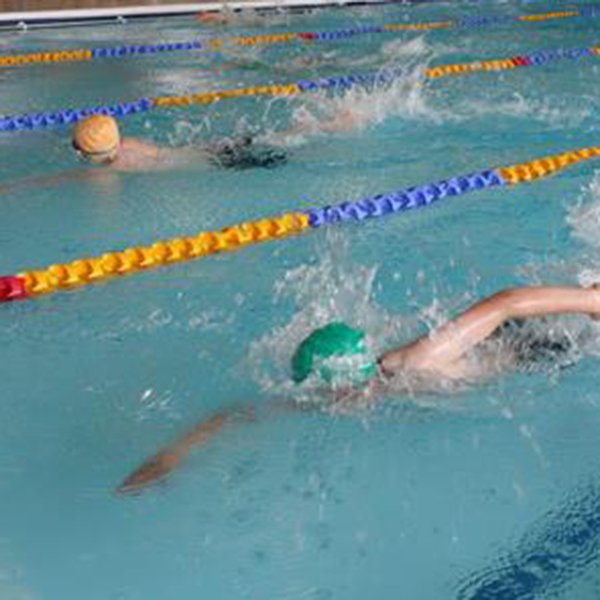
Stage 7
Stage 7 focuses on fully developing all four swimming strokes, as well as building stamina and improving diving skills. Swimmers should develop a quality stroke technique for up to 100 metres, incorporating the skills they have learnt throughout the stages and combining them to develop a linked routine.
They should successfully complete an obstacle course, which combines a variety of skills they have learnt from Stages 1 to 7.
Swimmers will have developed a range of skills in previous stages and these are now brought into a sequence.
By the end of this stage, swimmers will be able to swim 25 metres of all four strokes to Swim England’s recognisable Expected Standards. Swimmers will also be able to complete a continuous swim of 100 metres using three of these different strokes.
When our pupils have successfully completed Stage 7, our swimmers can progress on to our exciting developing Swim Squad and Lifesaving groups! Well done!
Stage 7 Curriculum
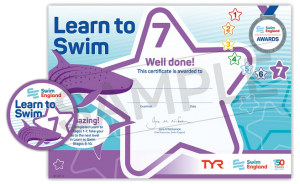
By completing this Award you will be able to:
- Push and glide and swim 25 metres backstroke (performed to Swim England expected standards).
- Push and glide and swim 25 metres front crawl (performed to Swim England expected standards).
- Push and glide and swim 25 metres breaststroke (performed to Swim England expected standards).
- Push and glide and swim 25 metres butterfly (performed to Swim England expected standards).
- Perform a movement sequence (linking skills with strokes and sculls) of one minute duration, in a group of three or more, incorporating a number of the following skills: Sculling: head first, feet first
Rotation: forward or backward somersault, log roll
Floating: star on the front or on the back, tuck float, create own
Eggbeater: Moving, lifting one or both arms out of the water - Perform a sitting dive or dive.
- Push and glide and swim 50 metres continuously using one stroke (performed to Swim England expected standards).
- Push and glide and swim 100 metres, using a minimum of three different strokes (performed to Swim England expected standards).
- Tread water using eggbeater action for 30 seconds.
- Complete an obstacle course (using minimum of four objects) with feet off the pool floor throughout.
You are now ready to move on to pre competitive swimming!! Well done!!




